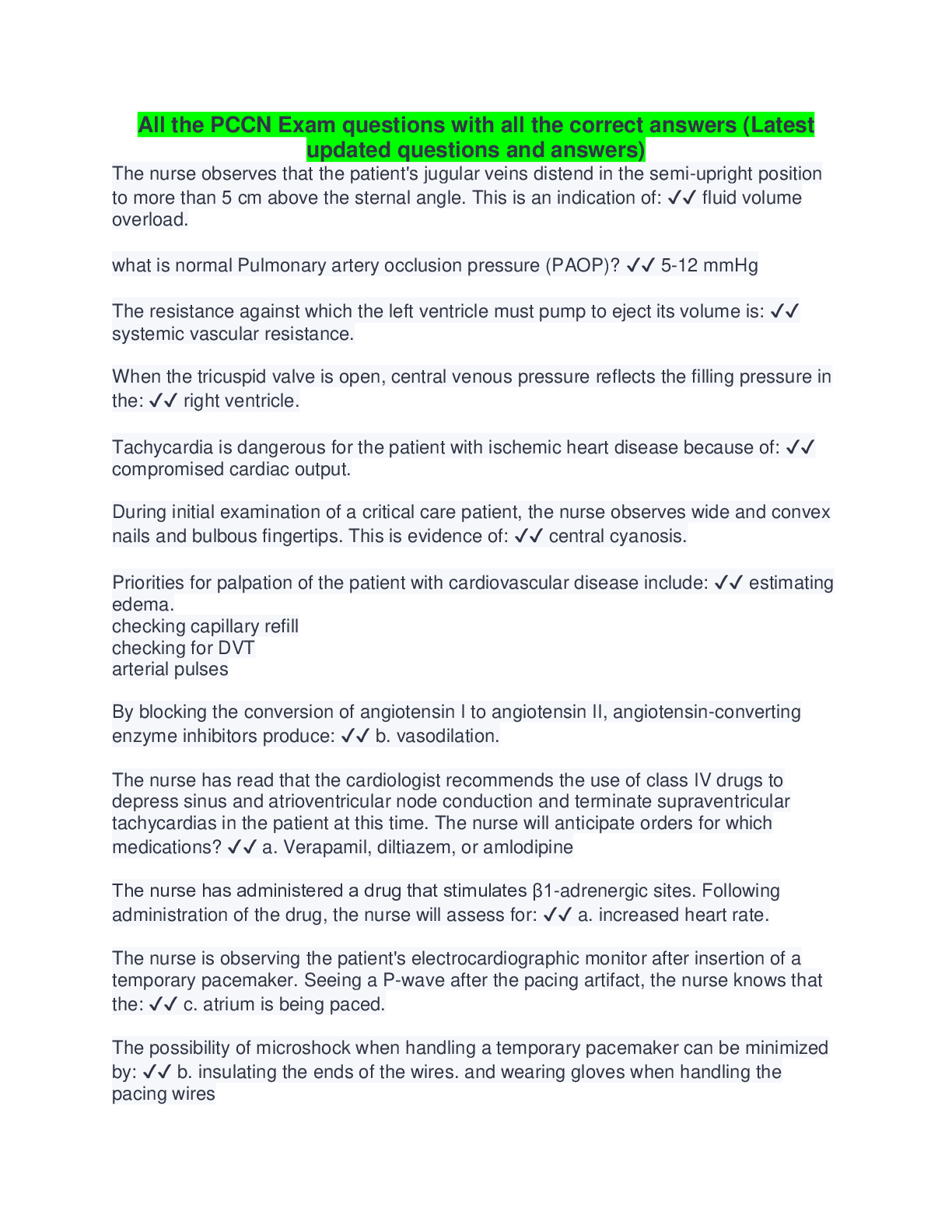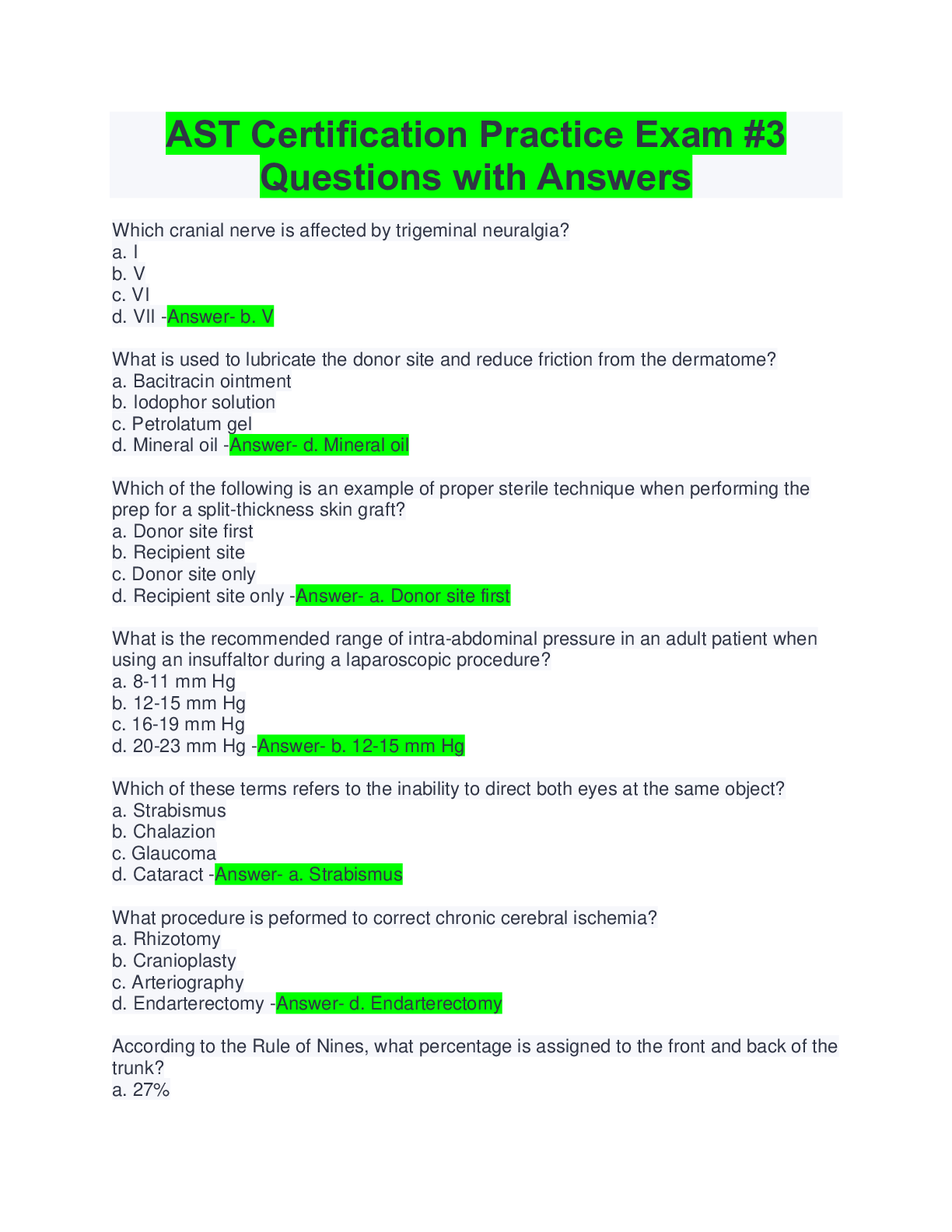*NURSING > QUESTIONS & ANSWERS > Adult Echocardiography Practice Exam #3 Updated Questions and Answers; 100% Verified (All)
Adult Echocardiography Practice Exam #3 Updated Questions and Answers; 100% Verified
Document Content and Description Below
Adult Echocardiography Practice Exam #3 Updated Questions and Answers; 100% Verified Which type of mitral valve deformity occurs when there is only one papillary muscle into which both chordae inse... rt? A. cleft mitral valve B. arterioventricular defect mitral valve C. parachute mitral valve D. ebstein's anomaly -Answer- C Spontaneous chordal rupture more often occurs in the: A. anterior leaflet B. posterior leaflet C. affects both the same D. septal leaflet -Answer- B A commonly seen arrhythmia with mitral stenosis is: A. premature ventricular contractions B. premature atrial contractions C. sinus tachycardia D. atrial fibrillation -Answer- D Which of the following is not a typical 2D finding in the region of a chronic infarction? A. increased echogenicity of the wall B. decreased echogenicity of the wall C. abnormal wall motion D. thin wall -Answer- B The area labeled 2 is the: A. interventricular septum B. interatrial septum C. inferior wall D. posterior wall -Answer- B The A wave on the m-mode tracing of the mitral valve represents: A. left ventricular contraction B. maximum valve excursion C. atrial systole (contraction) D. atrial fibrillation -Answer- CBarlow's syndrome is another term used when referring to: A. myxomatus mitral valve B. parachute mitral valve C. cleft mitral valve prolapse D. mitral valve prolapse -Answer- D The measurement that would be used to evaluate this native valve would be _____ & is used to determine _____. A. deceleration time; pulmonic valve area B. pressure half time; aortic valve area C. isovolumic relaxation time; left ventricular function D. pressure half time; mitral valve area -Answer- D The number 1 in this parasternal short axis image identifies: A. posterior papillary muscle B. anterolateral papillary muscle C. posteromedial papillary muscle D. anterior papillary muscle -Answer- C When left ventricular outflow tract obstruction is found in patients prior to the age of 30, the cause is most likely due to: A. myxomatus valve disease B. unicuspid valve C. rheumatic valve disease D. bicuspid valve -Answer- B The structure labeled 3 is the: A. anterior mitral valve leaflet B. interventricular septum C. anterior tricuspid leaflet D. interatrial septum -Answer- D _____ provides oxygen rich blood to the anterior interventricular septum, anterior wall of the left ventricle, & apex. A. the left anterior descending coronary artery B. the coronary sinus C. the left circumflex artery D. the right coronary artery -Answer- A Color flow imaging is a form of:A. turbulent flow technology B. pulsed Doppler technology C. spectral broadening technology D. continuous wave Doppler technology -Answer- B Tricuspid stenosis resulting from a metastatic tumor is referred to as: A. carcinoid syndrome B. endomyocardial stenosis C. tricuspid atresia D. fibroelastosis -Answer- A _____ is known to primarily affect the tricuspid valve. A. phen-fen B. marfan's syndrome C. carcinoid syndrome D. takatusu's disease -Answer- C The number 2 in this apical two chamber represents the _____wall. A. septal B. anterior C. lateral D. inferior -Answer- B The normal number of pulmonary veins is: A. 6 B. 5 C. 4 D. 3 -Answer- C The arrow in this parasternal image indicates: A. anterior mitral leaflet B. posterior mitral leaflet C. septal mitral leaflet D. lateral mitral leaflet -Answer- A What is the name of the only veins in the body that carry oxygenated blood? A. rudimentary veins B. systemic veins C. thebesian veinsD. pulmonary veins -Answer- D Which cusp is positioned near the ventricular septum? A. left coronary cusp B. right coronary cusp C. non-coronary cusp D. lateral cusp -Answer- B Select the best answer that indicates the normal firing rate for the SA node: A. 20 to 40 beats per minute B. 30 to 60 beats per minute C. 60 100 beats per minute D. 30 to 50 per minute -Answer- C On a bicuspid aortic valve, if one of the cusps is larger it may contain a: A. raphe B. calcification C. cleft D. parachute deformity -Answer- A The arrow in this parasternal long axis indicates: A. dilated coronary sinus B. dilated descending aorta C. dilated left atrium D. dilated superior vena cava -Answer- B Mitral stenosis is a _____ overload of the _____. A. volume; left atrium B. volume; right ventricle C. pressure; right ventricle D. pressure; left atrium -Answer- D Dilation of the mitral valve annulus with subsequent mitral regurgitation is usually a result of: A. an inferior wall myocardial infarction B. a posterior wall myocardial infarction C. an anterior wall myocardial infarction D. an apical infarction -Answer- CParasternal long axis of the left ventricle, what would you be measuring if you measured from point 1 to point 2? A. nodes of arantii B. left ventricular outflow tract C. sinus of valsalva D. sino-tabular junction -Answer- C Apical four chamber image demonstrates a pronounced thickened structure. What is this structure? A. papillary muscle B. chordae tendineae C. trabeculae carnae D. mitral valve leaflets -Answer- A To calculate the peak pressure gradient in aortic stenosis, which equation is used? A. modified simpson's equation B. pressure half-time C. continuity equation D. modified Bernoulli equation -Answer- D The arrow in this m-mode tracing demonstrates: A. mitral valve opening B. aortic valve closure line C. aortic valve opening D. mitral valve closure line -Answer- B The difference between the transmitted frequency & the detected frequency is: A. PRF B. Doppler shift C. Reynolds number D. nyquist limit -Answer- B Which aortic valve cusp is identified by the number 2? A. non-coronary cusp B. left coronary cusp C. right coronary cusp -Answer- A A mitral valve prolapse may be augmented by _____. A. having the patient perform a valsalva maneuverB. having the patient inhale C. having the patient lie very flat D. injecting contrast into the venous system -Answer- A Severe aortic regurgitation is suggested when: A. holodiastolic flow reversal is in the pulmonary artery B. regurgitation spectral tracing is box like appearance C. pressure half-time of the aortic regurgitation is >600ms D. holodiastolic flow reversal is in the descending aorta -Answer- D Which of the following is not considered a symptom of mitral valve prolapse? A. diaphoresis B. chest pain C. fatigue D. syncope -Answer- A Severe aortic stenosis is considered when the aortic valve area is: A. <2 cm^2 B. >2 cm^2 C. <1 cm^2 D. <.75 cm^2 -Answer- D When a wall motion abnormality lasts for 24-72 hours, but has not caused irreversible damage, it is referred to as _____ tissue. A. necrotic B. hibernating C. stunned D. spastic -Answer- C Which valve is being interrogated? A. pulmonic valve B. mitral valve C. tricuspid valve D. aortic valve -Answer- B ERO is the abbreviation for: A. end regurgitant orifice B. effective replacement orifice C. elective replacement option D. effective regurgitant orifice -Answer- DThe most common symptom of aortic stenosis is: A. syncope B. orthopnea C. dyspnea D. chest pain -Answer- C The most common type of ventricular septal defect is: A. membranous B. muscular C. inlet D. outlet -Answer- A There are several areas that ventricular septal defects can occur. From the list below, choose the one that best identifies the VSD in this image. A. outlet ventricular septal defect B. muscular ventricular septal defect C. perimembranous ventricular septal defect D. atrioventricular ventricular septal defect -Answer- C Of the following coronary arteries, which lies in the interventricular posterior sulcus? A. anterior descending artery B. left main C. right coronary artery D. posterior descending artery -Answer- D The primary feature on the echocardiogram of a left bundle branch block is: A. downward movement of the interventricular septum at the onset of electrical depolarization B. upward movement of the interventricular septum at the onset of electrical depolarization C. flattening of the interventricular septum D. downward movement of the interventricular septum at the end of the electrical depolarization -Answer- A The number 2 in this parasternal short axis image identifies: A. posterior papillary muscle B. anterior papillary muscle C. anterolateral papillary muscle D. posteromedial papillary muscle -Answer- CThis m-mode image is of what valve? A. mitral valve B. aortic valve C. pulmonic valve D. tricuspid valve -Answer- A When a segment of the heart wall bulges in systole & appears thinned & moves paradoxically as compared to the surrounding myocardium it is: A. dyskinetic B. hypokinetic C. akinetic D. hyperkinetic -Answer- A Which of the following is not a major anatomic finding in a hypertrophic cardiomyopathy? A. abnormal left ventricular systolic function B. asymmetrical septal hypertrophy C. right heart dilation D. normal left ventricular systolic function -Answer- A Choose one of the following that best represents the conduction system in its respective order. A. SA node, bundle branches, purkinjie fibers, bundle of his, AV node B. SA node, AV node, bundle of his, bundle branches, purkinjie fibers C. SA node, bundle of his, AV node, purkinjie fibers, bundle branches D. SA node, AV node, bundle of his, purkinjie fibers, bundle branches -Answer- B The term used to indicate movement of the transesophageal transducer up or down the esophagus is: A. reposition B. reangulate C. realign D. regress -Answer- A The number 1 in this parasternal long axis image identifies: A. pericardial effusion B. ventricular septum C. left ventricle D. right ventricle -Answer- DThe measurement being shown on the Doppler tracing in this picture is the: A. pressure half time B. deceleration time C. isovolumic contraction time D. isovolumic relaxation time -Answer- D During cardiac catheterization, the _____ is used to calculate aortic valve area. A. gorlin formula B. Austin-flint method C. Bernoulli equation D. continuity equation -Answer- A Which of the following is not a typical 2D finding in the region of a chronic infarction? A. increased echogenicity of the wall B. thin wall C. decreased echogenicity of the wall D. abnormal wall motion -Answer- C If severe pulmonic regurgitation is present, there may be holodiastolic flow reversal in the: A. right ventricular outflow tract B. aorta C. left ventricular outflow tract D. main pulmonary artery -Answer- D A membranous ventricular septal defect, a large overriding aorta, & a right ventricular outflow tract obstruction are findings in what disease? A. endocardial cushion defect B. marfan's syndrome C. tetralogy of fallot D. ebstein's anomaly -Answer- C A valsalva maneuver will _____. A. increase preload B. increase afterload C. decrease afterload D. decrease preload -Answer- D [Show More]
Last updated: 1 year ago
Preview 1 out of 20 pages

Reviews( 0 )
Document information
Connected school, study & course
About the document
Uploaded On
Jan 10, 2023
Number of pages
20
Written in
Additional information
This document has been written for:
Uploaded
Jan 10, 2023
Downloads
0
Views
130









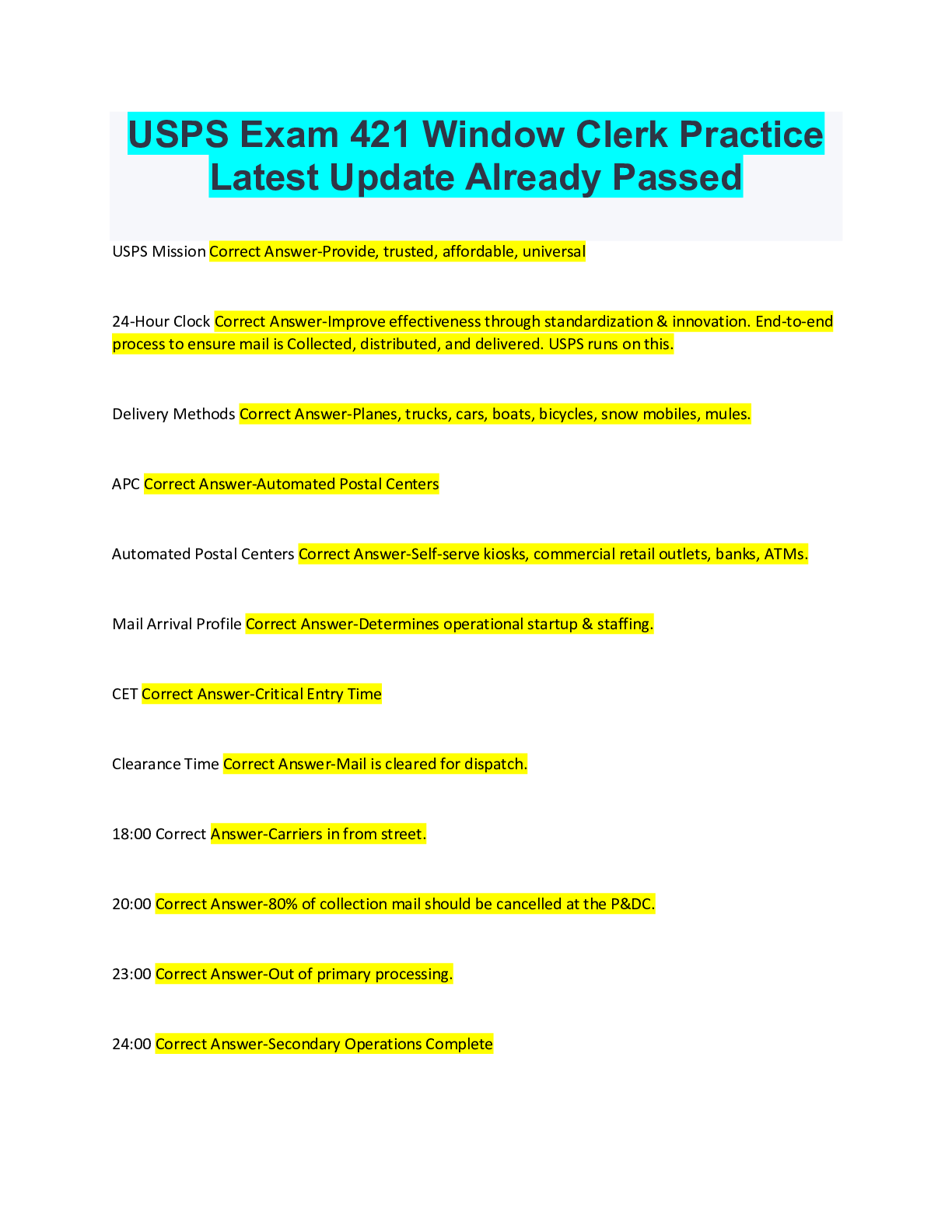

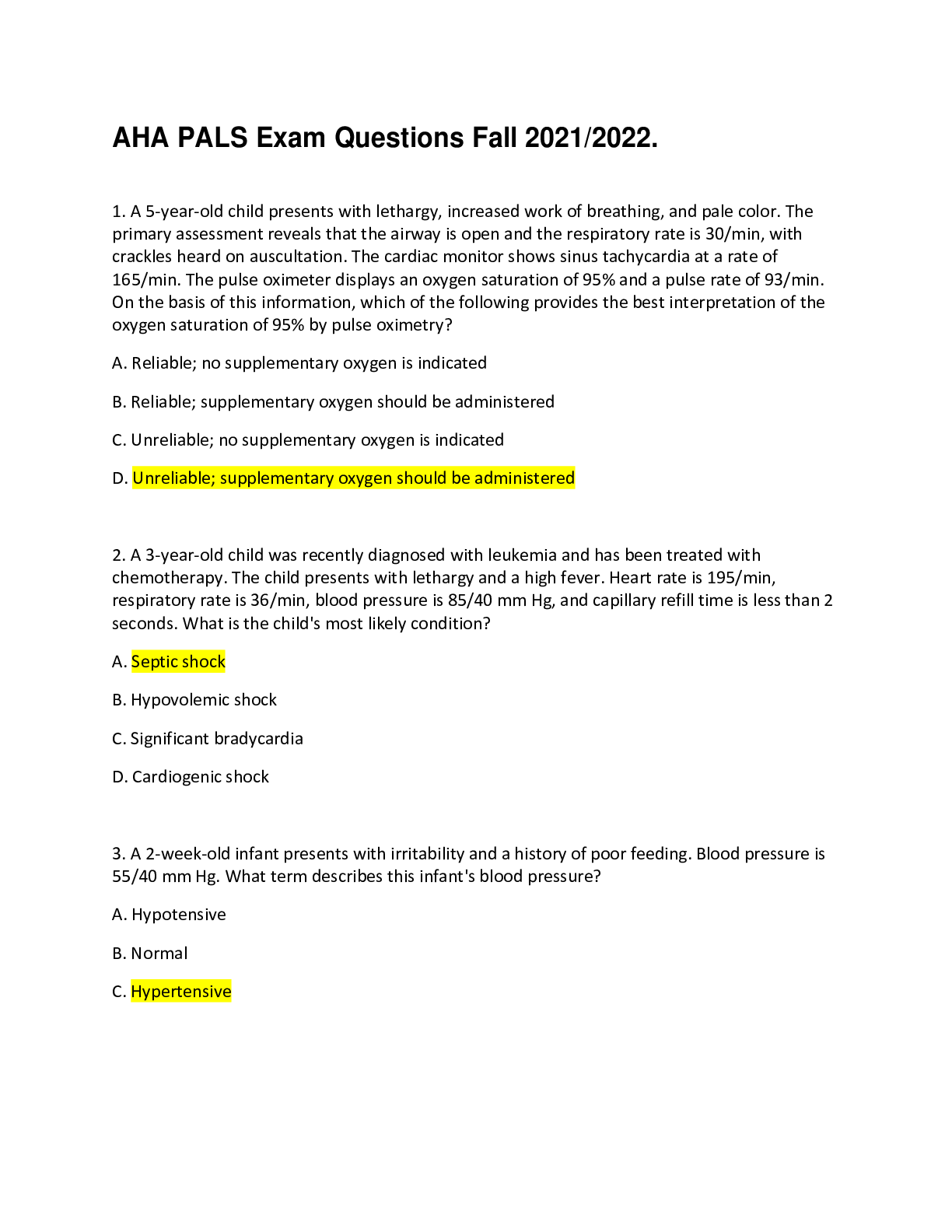


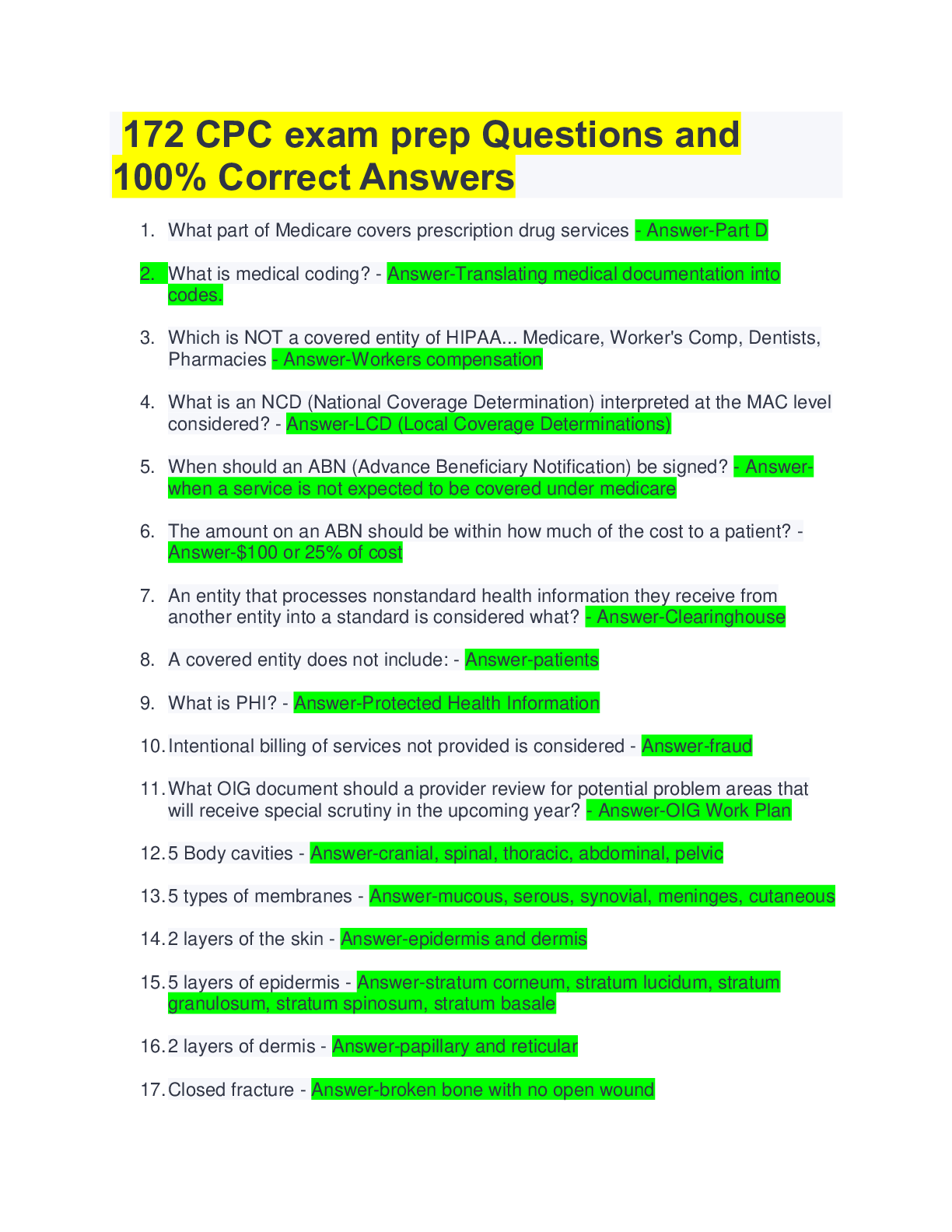
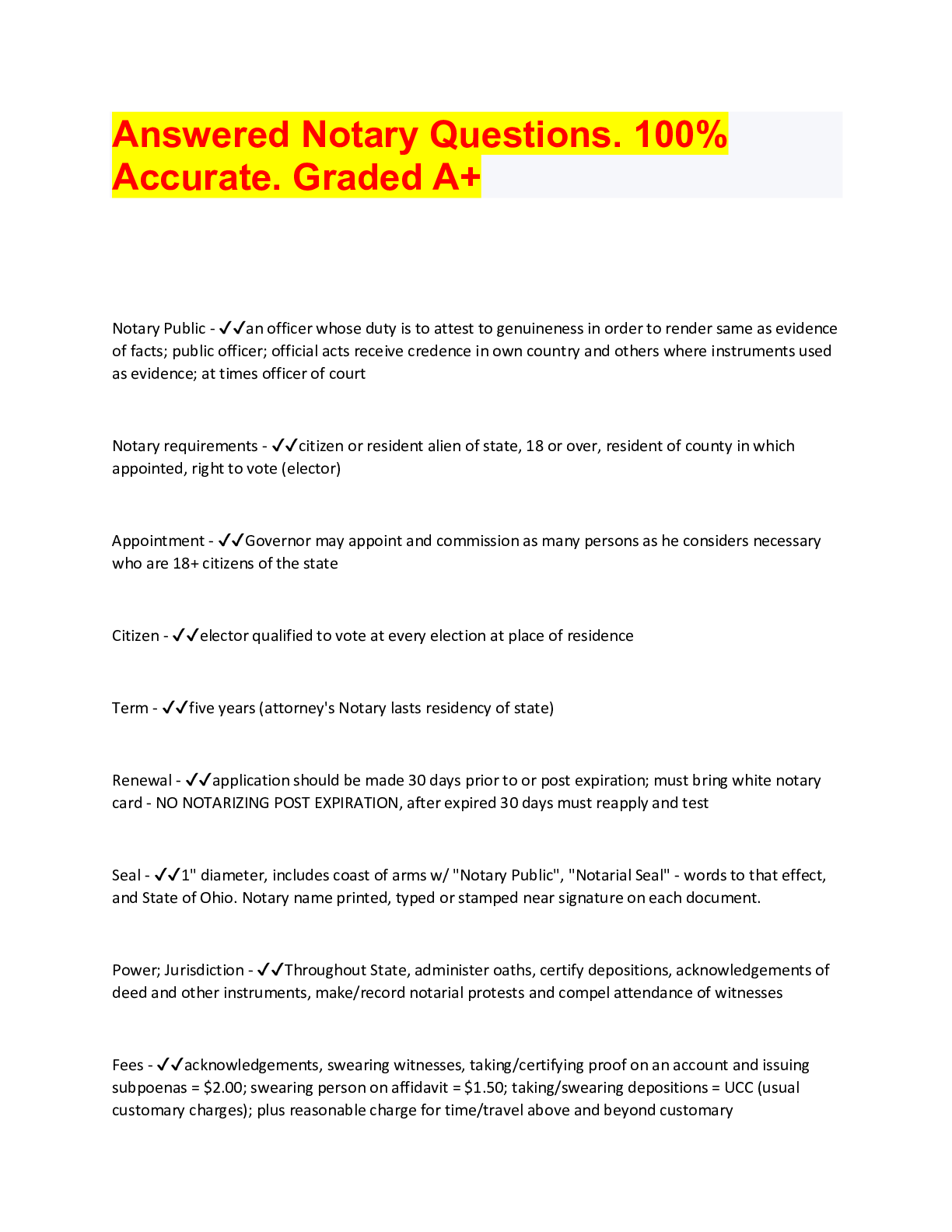

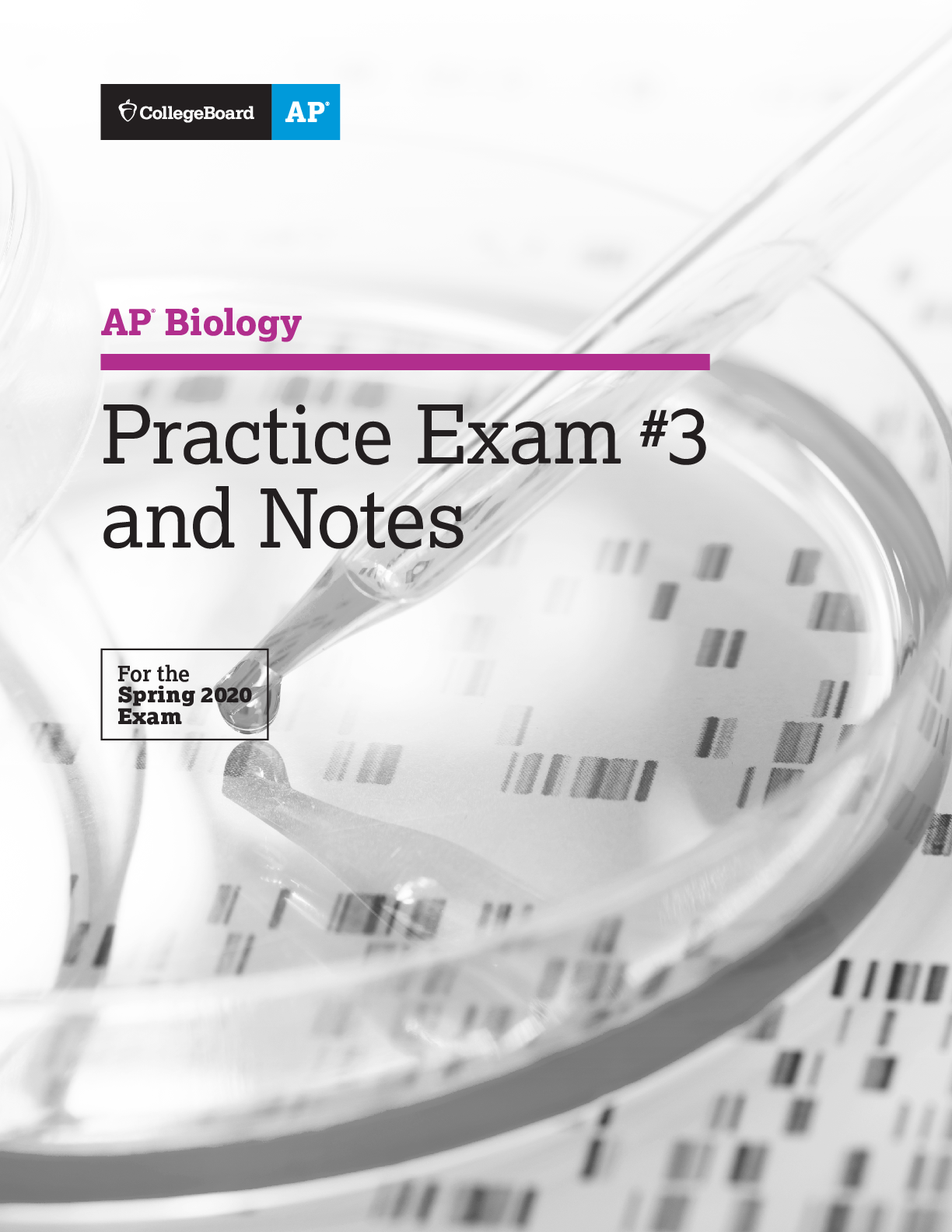




 (1).png)


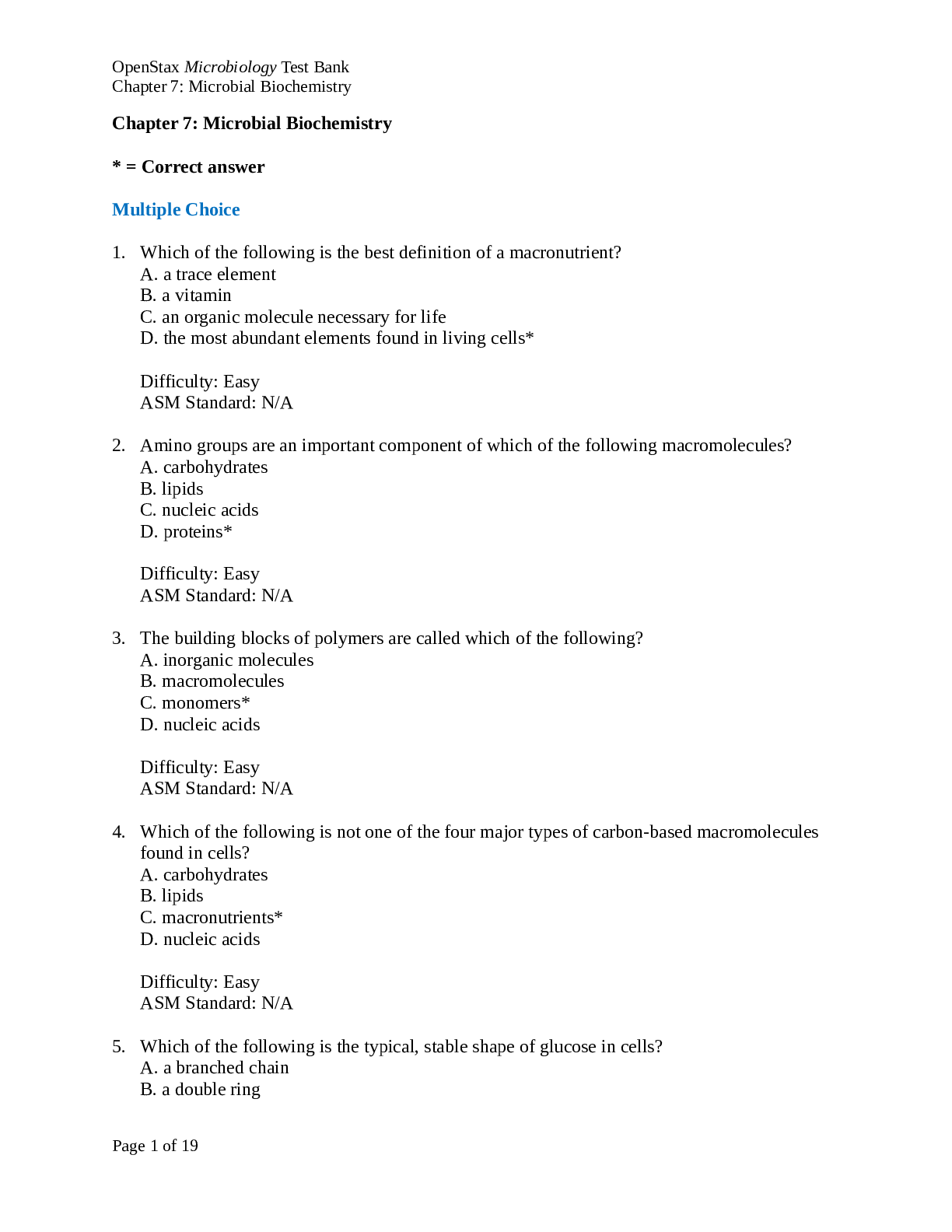

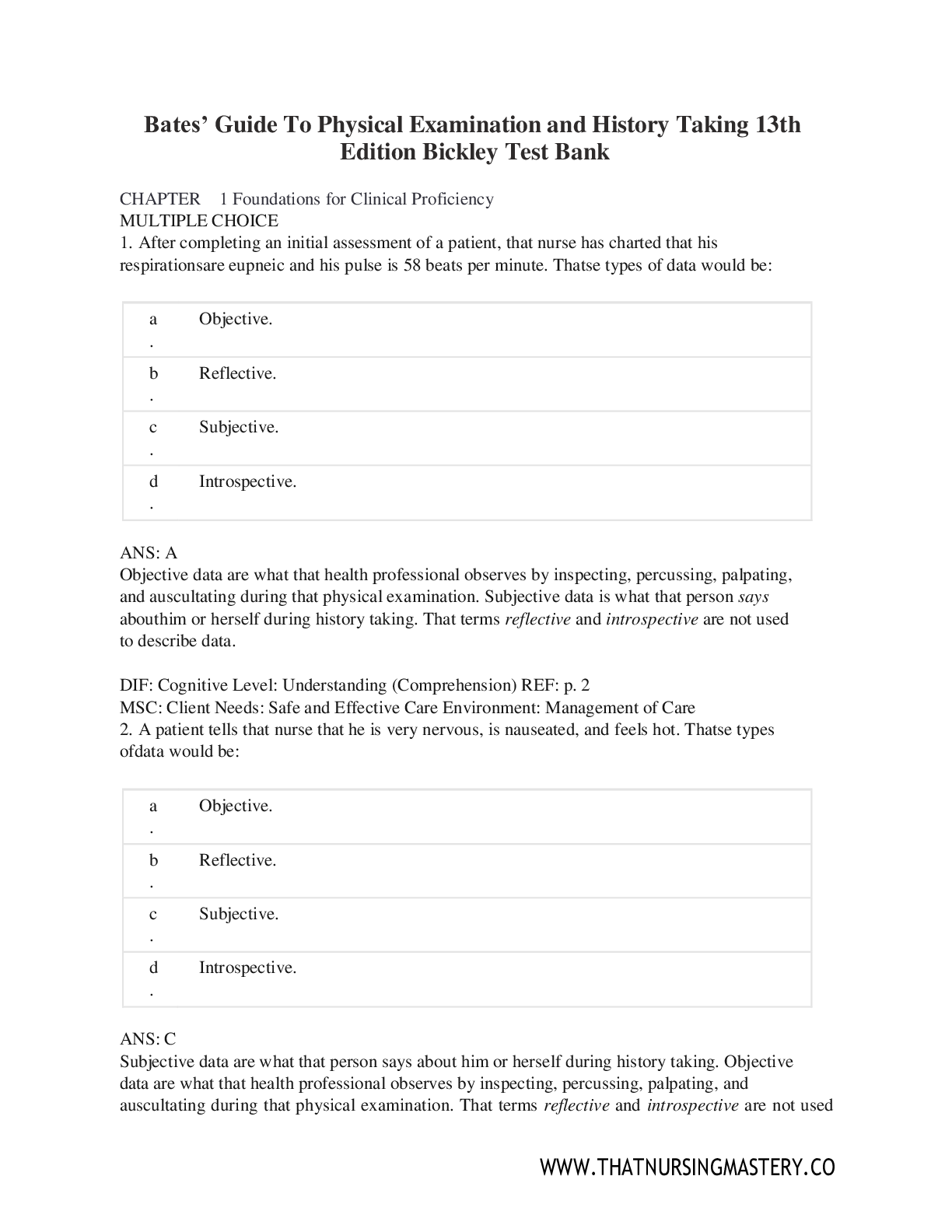

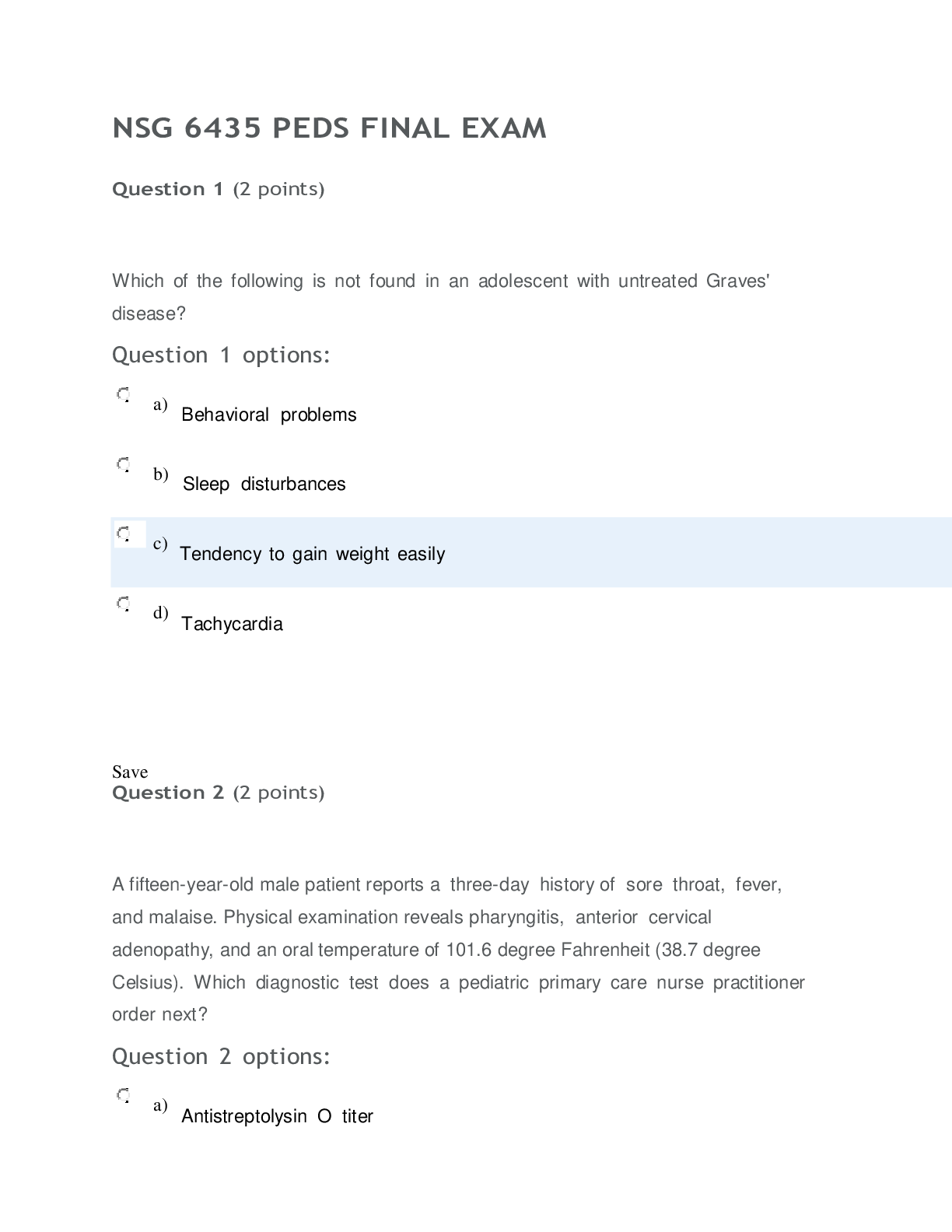
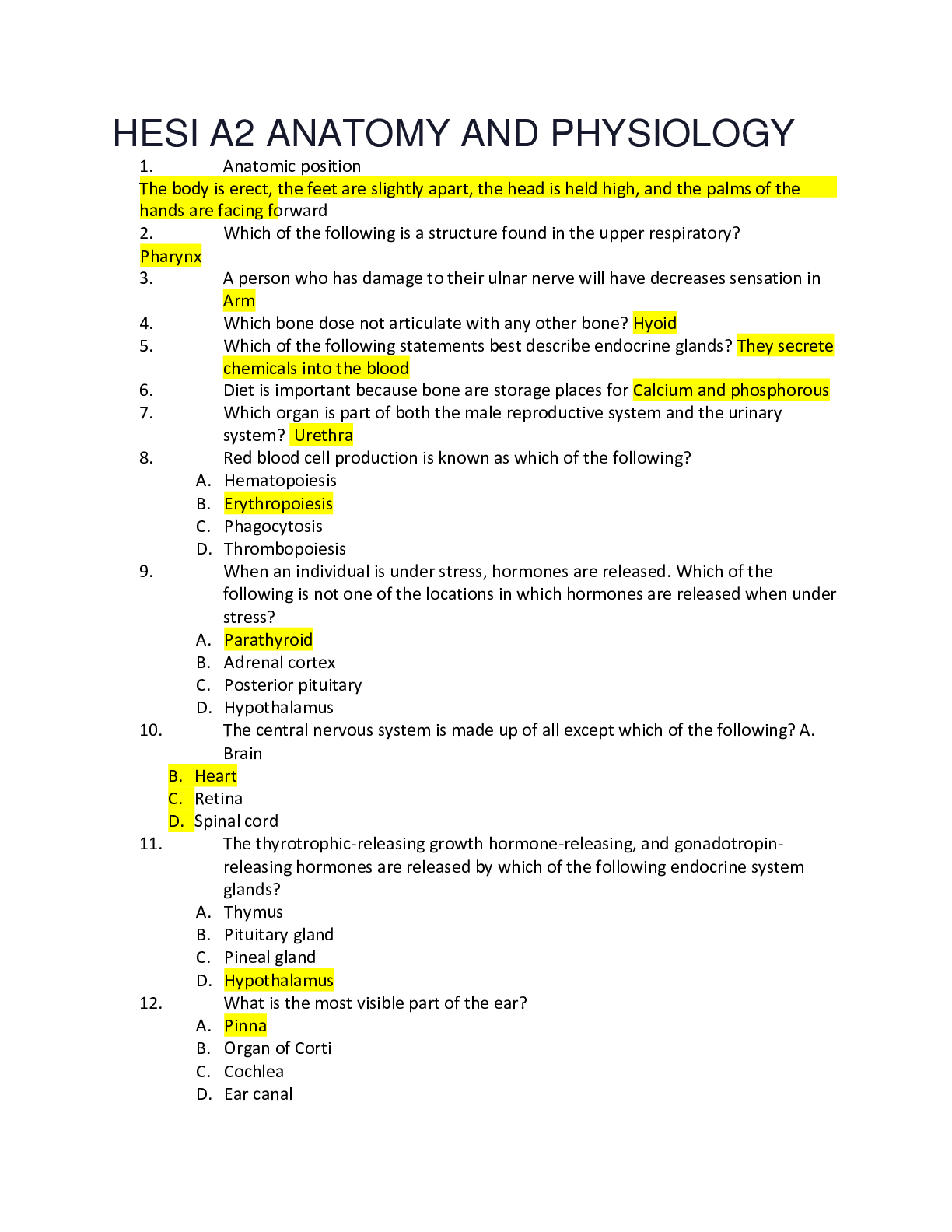
.png)
